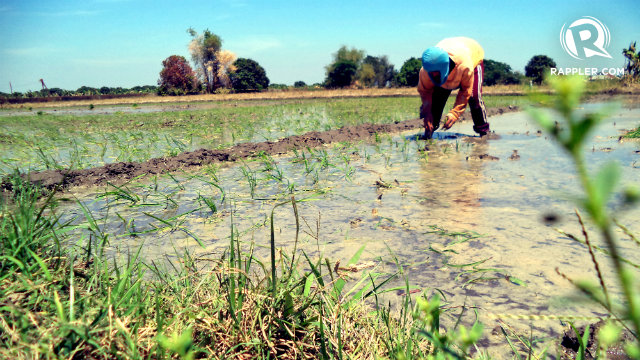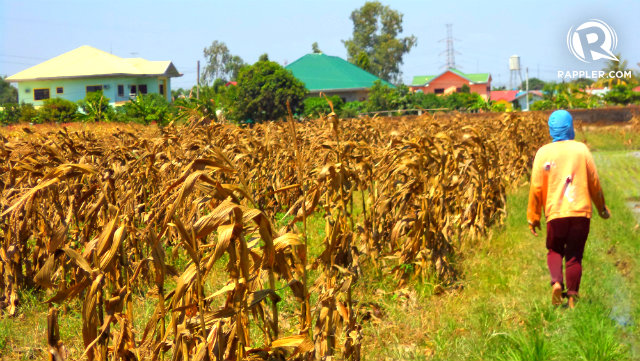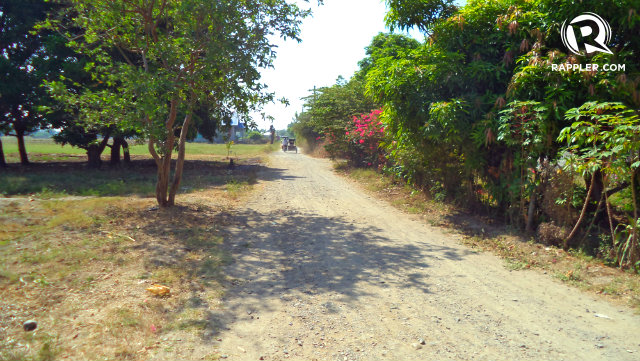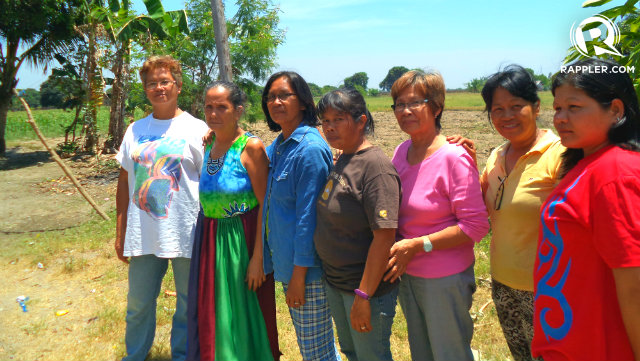SUMMARY
This is AI generated summarization, which may have errors. For context, always refer to the full article.
Filipino women in agriculture, like those in Baruya, refuse to remain invisible and undervalued as they continue to feed their families and the country
 MANILA, Philippines – The road was unpaved and the sun was unforgiving; it was almost impossible to hear your own thoughts drowning in the sound of a struggling motor engine.
The tricycle took its time crossing the rocky path. At the end of the road were the women of Baruya in Pampanga.
A woman named “Fe” was clad in sweater, sweatpants, and a shirt wrapped around her face. With minimal pauses, Fe bent under the sun, her feet dipped in water, and her hands tied to the land. This is home, this is work, this has been her life for almost 30 years.
MANILA, Philippines – The road was unpaved and the sun was unforgiving; it was almost impossible to hear your own thoughts drowning in the sound of a struggling motor engine.
The tricycle took its time crossing the rocky path. At the end of the road were the women of Baruya in Pampanga.
A woman named “Fe” was clad in sweater, sweatpants, and a shirt wrapped around her face. With minimal pauses, Fe bent under the sun, her feet dipped in water, and her hands tied to the land. This is home, this is work, this has been her life for almost 30 years.
 Fe does not have her own land; she plants rice in other people’s lands. Sometimes there is work, sometimes none.
She started farming at 20. She then tried working in factories, but missed life in the field. When she returned, she never stopped.
Today, Fe, together with her teenage son, had to plant over 3,000 square meters of land.
Most women in Baruya engage in agricultural work, but majority are landless, faceless, and buried in debt. Such is the life for most Filipino women in agriculture.
Food producers
The International Food Policy Research Institute (IFPRI) recognized women as “key to food security.” IFPRI argued that women supply all 3 pillars of food security:
Fe does not have her own land; she plants rice in other people’s lands. Sometimes there is work, sometimes none.
She started farming at 20. She then tried working in factories, but missed life in the field. When she returned, she never stopped.
Today, Fe, together with her teenage son, had to plant over 3,000 square meters of land.
Most women in Baruya engage in agricultural work, but majority are landless, faceless, and buried in debt. Such is the life for most Filipino women in agriculture.
Food producers
The International Food Policy Research Institute (IFPRI) recognized women as “key to food security.” IFPRI argued that women supply all 3 pillars of food security:
- Food availability: Women contribute to agricultural outputs, family food security, environmental maintenance
- Economic access to food: Women spend most of their income on food, child healthcare
- Nutrition security: Women invest more time in providing care and nutrition
|
Men |
Women |
|
|
32.8 |
25.7 |
|
1998 |
2012 |
|
|
Men |
P128.10 |
P223.53 |
|
Women |
P108.16 |
P208.30 |
|
Employment in Agriculture |
2008 |
2012 |
|
Men |
7,767,000 |
7,698,000 |
|
Women |
2,937,000 |
2,962,000 |
 Irrigation is another problem experienced by farmers nationwide.
The women of Baruya manually operate water pumps. Irrigation systems have not reached their area, resulting in poor harvests. “Kung hindi tuyo, baha kami,” Serrano said. (If not dry, our lands are flooded.)
On average, a farmer spends around P50,000/year on planting rice – seeds, equipment, water, supplies – these funds are mostly borrowed. They harvest twice a year, totaling around 70 sacks of rice. Most of their income, however, is spent on paying off loans. (READ: Why PH agriculture is important)
When calamities hit, their losses are greater than their capital and earnings combined, losing up to P100,000. (READ: How climate change threatens food security)
During off-season, the women find other sources of income like sewing and raising livestock.
Farmers also compete with business moguls for land – many agricultural lands are converted into commercial or residential areas – threatening livelihoods and homes.
In the Philippines, it is common to see rice harvests and fish being dried on the roadsides. This is because most farmers lack access to post-harvest and storage facilities. Some farmers skip post-harvest procedures and sell their harvest for a cheaper price.
“Imbes na P13/kilo benta, P9 lang,” Castro explained. (Instead of P13/kilo, we settle for P9.)
Irrigation is another problem experienced by farmers nationwide.
The women of Baruya manually operate water pumps. Irrigation systems have not reached their area, resulting in poor harvests. “Kung hindi tuyo, baha kami,” Serrano said. (If not dry, our lands are flooded.)
On average, a farmer spends around P50,000/year on planting rice – seeds, equipment, water, supplies – these funds are mostly borrowed. They harvest twice a year, totaling around 70 sacks of rice. Most of their income, however, is spent on paying off loans. (READ: Why PH agriculture is important)
When calamities hit, their losses are greater than their capital and earnings combined, losing up to P100,000. (READ: How climate change threatens food security)
During off-season, the women find other sources of income like sewing and raising livestock.
Farmers also compete with business moguls for land – many agricultural lands are converted into commercial or residential areas – threatening livelihoods and homes.
In the Philippines, it is common to see rice harvests and fish being dried on the roadsides. This is because most farmers lack access to post-harvest and storage facilities. Some farmers skip post-harvest procedures and sell their harvest for a cheaper price.
“Imbes na P13/kilo benta, P9 lang,” Castro explained. (Instead of P13/kilo, we settle for P9.)
 The women also expressed dismay over the lack of farm-to-market roads (FMRs). Aside from lost food and income, poor FMRs disrupt access to hospitals and schools. “May namatay nang buntis, in labor, sobrang tagtag ng daan,” a woman narrated. (A pregnant woman died in labor, the road was too bumpy.) (READ: The future of PH rural roads)
‘Just’ a woman
The women also expressed dismay over the lack of farm-to-market roads (FMRs). Aside from lost food and income, poor FMRs disrupt access to hospitals and schools. “May namatay nang buntis, in labor, sobrang tagtag ng daan,” a woman narrated. (A pregnant woman died in labor, the road was too bumpy.) (READ: The future of PH rural roads)
‘Just’ a woman
 Until today, many families still favor sons over daughters – land titles are usually given to male heirs. “’’Di raw marunong magsaka ang babae,” a woman said. (They think women can’t farm.)
Elvie Fadriquelan of the National Rural Women Coalition – a farmer and community organizer – demanded that Filipinos look at women in agriculture more positively. “’Wag maliitin ang magsasaka, kung wala kami, wala tayong kakainin.” (Don’t belittle farmers, without us, we can’t eat.)
“Ang babae, ‘di lang nakahilata sa bahay,” she added. (Women are not just lying around at home.)
Fadriquelan said she wants government to educate farmers so that they can better defend and claim their rights. “Karamihan ‘di marunong magbasa’t magsulat. Maloloko sila sa papeles,” (Most are illiterate, they can be deceived in land titles.)
Because many of them have been working as children, they were unable to study.
The women of Baruya hope government can help improve Philippine agriculture, so that the youth will be encouraged to join and support the sector. – Rappler.com
Do you have stories to share or issues you want to raise? You can send your articles, thoughts, research and video materials to move.ph@rappler.com. Be part of the #HungerProject.
Until today, many families still favor sons over daughters – land titles are usually given to male heirs. “’’Di raw marunong magsaka ang babae,” a woman said. (They think women can’t farm.)
Elvie Fadriquelan of the National Rural Women Coalition – a farmer and community organizer – demanded that Filipinos look at women in agriculture more positively. “’Wag maliitin ang magsasaka, kung wala kami, wala tayong kakainin.” (Don’t belittle farmers, without us, we can’t eat.)
“Ang babae, ‘di lang nakahilata sa bahay,” she added. (Women are not just lying around at home.)
Fadriquelan said she wants government to educate farmers so that they can better defend and claim their rights. “Karamihan ‘di marunong magbasa’t magsulat. Maloloko sila sa papeles,” (Most are illiterate, they can be deceived in land titles.)
Because many of them have been working as children, they were unable to study.
The women of Baruya hope government can help improve Philippine agriculture, so that the youth will be encouraged to join and support the sector. – Rappler.com
Do you have stories to share or issues you want to raise? You can send your articles, thoughts, research and video materials to move.ph@rappler.com. Be part of the #HungerProject. Add a comment
How does this make you feel?
Loading
There are no comments yet. Add your comment to start the conversation.